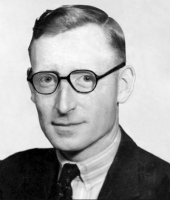










Tommy Flowers (1905 - 1998) was a British Electronics Engineer. During WWII, when he worked for the General Post Office (GPO), later British Telecom (BT), he designed and co-developed Colossus, the first programmable electronic computer that was used to break the German Lorenz SZ-40/42 cipher machine. The image below shows Tommy Flowers when he was in his late thirties, probably around the time he developed Colossus.
Tommy Flowers was born in London's West End as the son of a bricklayer. At the age of 16 he took an apprenticeship in mechanical engineering at the Royal Arsenal (Woolwich, UK). At the same time he took evening classes at the University of London in order to obtain a degree in electrical engineering.In 1926, only 20 years old, he took a job at the telecommunications branch of the General Post Office. Four years later, in 1930, he was posted at the GPO research station at Dollis Hill (north-west London), where he explored the use of valve-based electronics for telephone exchanges.
Until that time, telephone exhanges were relay-based electro-machanical systems, but Flowers was conviced that an all-electronic exchange with thermionic valves was feasible. This insight would prove crucial for his later war-time work. In February 1941, he was asked by his director W Gordon Radley to assist BP codebreaker Alan Turing with the design of an electronic decoder for his Bombe machine at Bletchley Park.Although the decoder project was later cancelled, Turing was impressed with the work and the insights of Flowers and, in 1943, introduced him to Max Newman who was leading a team that wanted to automate the cryptanalysis of the Lorenz SZ-40/42 cipher machine. This machine, called TUNNY by the codebreakers, was so complex that it could not be broken manually.
Tommy Flowers and his colleague Frank Morell subsequently developed the Heath Robinson, the first machine that was used to break TUNNY. The codebreakers called teleprinter ciphers 'FISH'. Once Heath Robinson was running, Flowers proposed a much more complex solution to Newman, that would generate the wheel patterns of the Lorenz SZ-40/42 (the TUNNY machine) electronically. He called the machine 'Colossus' as it would contain perhaps 1800 valves, whereas the most complex device that had been built at the time contained 'just' 150 valves.
His ideas were met with great scepticism by people like Gordon Welchman who believed that valve-based circuits could never be made reliable enough for such heavy work. Although the BP management did not approve of Flowers's ideas, he was supported by the director of Dollis Hill, W Gordon Radley. Flowers ignored the critisism and pushed through. In just 11 months, he and his dedicated team were able to demonstrate the first Colossus at Dollis Hill in November 1943. It immediately impressed the Bletchley Park staff. The machine, that would later be identified as Colossus Mark 1, contained 1500 valves and was five times faster than the Heath Robinson. More importantly, it was more flexible than the Heath Robinson that used electro-mechanical switches. The Colossus Mark 1 was moved to Bletchley Park in January 1944 and put to work.
In the meantime, Flowers had already started the design of Colossus Mark 2, a computer that would contain no less than 2400 valves. More importantly it was built in less than five months!
The first Colossus Mark 2 was delivered at Bletchley Park on 1 June 1944 and immediately produced vital information for the upcoming D-Day landings (6 June 1944). A message intercepted on 5 June 1944 confirmed that Hitler didn't want to move additional troops to Normandy as he was convinced that the landings would take place elsewhere.In total, 10 Colossi were built and installed during WWII with an 11th being ready by the end of the war. Once the war was over, all but two Colossi were dismantled and the parts were reused. The remaining two machines were moved to GCHQ in Cheltenham where, presumably, they played an important part in the codebreaking efforts during the Cold War. They were eventually dismantled in 1959 and 1960 when newer and better techniques had become available.